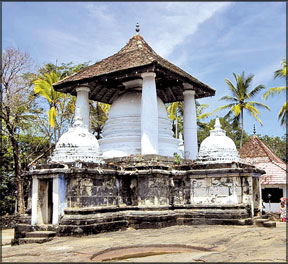|
Buddhist Spectrum
Gadaladeniya Temple:
FUSION devotion
Prof. W. I. SIRIWEERA
The Gadaladeniya temple is located on a small hill top three
kilometres away from Pilimatalava on the Ambilmigama-Davulagala road in
the Yatinuwara electorate of the Kandy district. The rock inscriptions
found there refer to the monument as Dharmakeerthi Viharaya. The name
given by the Nikayasangrahaya is the Saddharmatilaka Viharaya. It is the
Saddharmaratnakara written in the fifteenth century which first referred
to the site as the Gadaladeni Viharaya.

The monument had been constructed during the reign of the first king
of Gampola, Bhuvanekabahu IV (1341-1351) on the initiative of a bhikkhu
named Silavamsa Dharmakeerthi. Bhikkhu Dharmakeerthi had lived in South
India for a short period as a pupil of a Chola monk.
The architect of the temple complex was also a South Indian named
Ganesvaracharya. These South Indian connections partly explain why
Dravidian influences, particularly Pandyan and Vijayanagara influences
are predominant in the architectural forms of the Gadaladeniya Temple.
The Gadaladeniya shrine has been mostly constructed of granite. The
most striking part of the stone work is the porch at the entrance which
is located in a Northerly direction.
Its roof is built of huge monoliths and rests on large stone pillars
with two small pillars besides them. Thus there are three pillars on
each side of the porch. Sculptures such as lotuses, dwarfs, wrestlers,
dancers, flute players and lions are found on these pillars.
Buddha and God worships
The ground plan of the shrine at Gadaladeniya reflects a synthesis of
the Buddha worship and the worship of gods. In fact the synthesis of the
worships of the Buddha and gods became more and more popular during the
early medieval period due to South Indian influences.
The Gadaladeniya precinct is one of the earliest shrines which
reflect this phenomenon. The great popularity of the worship of gods is
also testified by the Sandesa poems of the Gampola and Kotte periods
which plead protection, patronage and blessings of gods to royal
personalities.
The main shrine at Gadaladeniya facing the East is devoted to the
Buddha seated on a Vajrasana or a 'Diamond Throne' in the meditating
posture (dhyana mudra). The structure of this statue has been made with
bricks over which sand and lime plaster had been applied.
Near the seated Buddha a 2.5 feet tall bronze Buddha image has been
placed.
This bronze statue is similar to Buddha images in Nalanda in Eastern
India and differs from any known Buddha statue of Sri Lankan origin. The
form of the lotus pedestal and the manner in which the robe is worn are
characteristics of the Nalanda type.
It is believed that this image was brought either from South India or
from a country in South East Asia.
The interior of this main image house including the ceiling has been
decorated with paintings. The colours used are red, yellow and black.
These paintings in fact mark the beginnings of Kandyan style of
paintings. Unfortunately at present, only the patches of original
paintings are visible.
Next to the main shrine in a southerly direction is the sanctum of
god Upulvan or Varuna. Its entrance has been made through the exterior
wall on the Southern side.
The monastery or Avasa Ga at Gadaladeniya though renovated time and
again, too contain traditional characteristics. The living rooms of
bhikkhus have been constructed surrounding a central courtyard or Meda
Midula. The backyard of the monastery has been set apart mainly for the
kitchen and the alms hall.
Literary contribution
The Gadaladeni monastery has contributed immensely to the literary
development during the era of Gampola kings.
Jayabahu Devarakkhita, a pupil of Sangharaja Silvamsa Dharmakeerthi
was the author of Nikaya Sangrahaya which contains the history of
Buddhism in Sri Lanka from the time of the Buddha up to the reign of
Bhuvanekabahu V. The well-known Sinhalese prose work, Saddharmalankara;
a collection of stories based on the Pali Rasavahini; the Sinhala
paraphrase (sanne) of the Pali grammatical text: Balavatara and the Pali
poetical work Jinabodhavali were also compiled by the resident bhikkhus
of the Gadaladeni monastery in the fourteenth century.
The Gadaladeni temple had been renovated several times in the
subsequent centuries. The most important repairs had been done during
the reigns of Parakramabahu VI (1412-1467) of Kotte and Sri
Viraparakrama Narendrasinghe (1707-1729) of Kandy. A few new features
have been added to the complex in the twentieth century.
They are small degobas surrounding the original Degoba, Dadimunda
Devalaya or the Lower Temple and the Bodhighara.
The ten perfections
Dr Senarath Tennakoon
There are ten virtuous qualities that lead to Buddhahood. These are
the ten perfections (dasa-paramita) mentioned in the Pali sources. The
Cariyapitaka and the Buddhavavamsa of the Kuddaka Nikaya of the Pali
Canon contain details of these ten perfections.

In Sanskrit paramita means “crossed over” and in Mahayana Buddhism, a
perfection is a virtuous quality practiced by a being oriented towards
enlightenment (Bodisattva) in the course of his spiritual development.
Originally there were six such qualities. Later the number was increased
to ten to complement the ten stages or levels (bhumi) of a
“bodhisattava's career. (Keown, 2003). These are often referred to as
perfection doctrines (parami dharma).
Although the fulfillment of these doctrines is targeted towards the
attainment of Nibbana, these could be practiced for the success of ones
life process in the forward movement towards the achievement of Nibbana.
The ten paramis are generosity (dana), morality (sila), renunciation (nekhamma),
insight (panna), energy (viriya), patience (kanthi), truthfulness (sacca),
resolution (adhitthana), loving kindness (metta) and equanimity (upekkha)
respectively.
Attachment
Generosity (dana) is a sources of great merit (punya). It is
instrumental in overcoming selfishness and attachment. While in
Theravada dana in general equates to the practice of offering alms to
monks and lay people.
In Mahayana it usually refers to the Perfection of Generosity (dana-paramita)
Many Buddhists are aware of Vessantara Jatakaya where Prince Vessantara
gave away his magic elephant that ensures adequate rainfall to another
state as there was a severe drought in that state. Later he gave away
his two children to serve as slaves to an old ugly Brahmin who had a
young pretty wife.
He was about to give off his queen too when the gods intervened and
prevented it. Sri Lankan Buddhists are familiar with the story of King
Sri Sangabo who became an ascetic leaving aside the throne, donated his
head to a peasant so that he could receive the prize of gold from King
Gotabahaya who was afraid of Sri Sangabo's regaining power. According to
the Mangala Sutta generosity is a blessing and it is one distinguishing
feature of a virtuous/good person. There are three types of dana, namely
amisa dana, abhaya dana and dhamma dana.
Dhamma dana is helping or assisting one in the spiritual development
and is regarded as the best out of all the three types of dana.
Preaching the Dhamma, discussions on the Dhamma, writing books on the
Dhamma etc are included in dhamma dana.
A;misa dana is offering food, cloths, medicines and shelter to the
Bhikkus and other material things including money to others. By offering
food the recipient is subject to gain in life, beauty, happiness,
strength, and intelligence (ayu, vanna, skha, bala, panna) and the giver
gets rid of greed and selfishness.
Abhaya dana is protecting subjects from the dangers of fire, water,
enemies and other risky situations. Generally some undertake to release
animals specially cattle and goats awaiting slauter. The benefits of
abahaya dana are longevity and freedom from enemies.
Morality (sila) is the second perfection and it is the key that
guides behaviour and cultivates virtue. Morality is crystallized in the
five precepts (pancha sila) practiced by the lay Buddhists. These are
(1) not to kill or injure living creatures (2) not to take what has not
been given (3) to avoid misconduct in sexual matters (4) to abstain from
false speech and (5) not to take intoxicants.
These Five Percepts are the corner stones of Buddhist morality,
particularly of the lay Buddhists. Sometimes they observe eight precepts
which include in addition abstaining from taking food at inappropriate
times, abstaining from dancing singing music unseemly shows, using
garlands, perfimes, and beautifying agents and abstaining from using
high and big luxuries seats.
Eloquent
The quality ingredients under silu increase in respect of the Bhikkus
(adhi si la) and Bhikkunis. In the Noble Eightfold Path the first of its
three divisions that includes steps 3-5 namely (3) Right Speech (samma
vaca) (4) Right Action (samma;kammanta), and (5)Right Livelihood (samaajeva)
are grouped under sila Sigalova da Sutta is an eloquent discourse on the
duties pertaining to the society covering even the servants, employees,
and ascetics where wholesome human relationships should be developed.
This Sutta is often called ‘householder's vinaya as it contains
practical moral advice for the laity, Renunciation (nekkhamma) is
abandoning household life of sensual gratification. The great
renunciation of Prince Sddhartha is well known to all Buddhists Leaving
behind all riches, royal comforts and family life. He became an ascetic
in search of Enlightenment and thus sacrificed.
His happiness for the sake of the suffering human beings. King Sivi,
King Vessantara and guild leader Sumadha are well known figures in
Buddhist literature that enjoyed the highest luxuries before giving up
these for the sake of others. King Makadeva having observed one lock of
his hair turning grey decided to give up royal comforts. The Bhikkus and
Bhikkunis under the Buddhist Order have given up all family ties and
household life to serve humanity, shaving their heads and wearing
saffron robes.
Insight, wisdom or knowledge (panna) is prajnna in Sanskrit and
indicates discriminative knowledge or intuitive apprehension pertaining
to the truth in Buddhist teachings. In Abhidahhama it is defined as the
analytical discrimination of phenomena (dharma-pravicaya).
Although all human beings possess prajna to some extent has to be
cultivated and developed through the practice of insight meditation (vipassana)
or similar forms of mental training (Keown, 2003) Panna is essentially
the right understanding of the nature of the world in respect of
impermanence (anicca), suffering/unsatisfactoriness (dukka) and
soullessness (anatma) A Bodisatta Meditates on these aspects of human
life. The Bodhisatta strives to reconstruct through the realistic
analysis and interpretation of the five aggregates or the five
components of the human individual for achieving the goal of Nibbana.
Wisdom is the apex of Buddhism. It is the first factor in the Noble
Eightfold Path (samma ditti).
It is one of the seven factors of Enlightenment (Dhamma Vicaya
Sambojjhanga). It is one of the four means of Accomplishments (vima nsa
Iddipada). It is one of the five powers (pancabala) and one of the five
controlling faculties (pannindriya.
It is wisdom that leads to purification and to final Enlightenment (Narada,
1985). There is a long history in the compilation of discourses on The
perfection of Insight (prjana paramita sutras) which advocate the
Bodisatva ideal as the highest form of religious life and the
significance of insightful understanding of phenomena (dharma). Conze
Edward (1904-79) a leading German Buddhist scholar conducted pioneering
work on Prajhna-Paramita Sutras.
“There is no concentration to him who is without wisdom; there is no
wisdom to him who does not concentrate.
In whom there is concentration and wisdom, he indeed is near to
Nibbana” is a translation of the verse 372 of the Dhammapada (Piyadassi,
1987). Patience (kanthi) is the patient endurance of suffering inflicted
upon oneself by others, and the forbearance of others’ wrongs (Narada,
2006).
The Khantivadi Jataka and the Kakacupama Sutta highlight the
importance of practicing extreme patience and forbearance towards evil
doers. When the Buddha was an ascetic named Khantivadi in a previous
birth long ago (Bodisatta) his power of patience was put into test by
the king of Benaris. The king flogged, the ascetic, chopped his hands
and feet, but could not make the ascetic angry.
Patience
The first four verses in the Elephant section (Naga Vagga) in the
Dhammapada deal with patience. The first verse (no: 320) states that as
most people are wicked I will endure their harsh words like an elephant
in the battle field which endures the arrows. The second verse (no: 321)
states that the tamed and restrained elephant can be taken to a crowd.
The king rides a tamed elephant. The best among the men are those who
can endure abuse.
The third verse (no: 322) states that the retrained mules and well
bred Sind horses and the great Kungura elephant are excellent. But the
self restrained are nobler than them. The fourth verse (no: 323) has
been translated by Dr O R Medonza as: (Not indeed in this kind of
vehicles could unexplored regions be reached; who himself is very well
controlled, the controlled goes with restraint. (Medonza, 1960). In
essence patience is the expression of strategic knowledge with a kind
disposition of the mind Courage (Viriya).
The other terms for courage are perseverance and energy but it does
not refer to courage in physical strength.
It is defined as the persistent effort to work for the welfare of
others both in thought and deed (Narada, 1985). He who plants thorns
shall not gather roses and there is no honey without a string. Necessity
is the mother of invention. All these proverbs emphasize the need for
persistent Endeavour towards achieving an objective.
Path to deathlessness
Premasara Epasinghe
The chapter 2 of Dhammapada relates Appamada Vagga - “Headfulness” -
which comprises verses 21 to 32. The verses 21, 22 and 23 depicts the
story of Samavati one of the queens of King Udena of Kosambi.

The three stanzas are as follows:-
Appamado Amatapadam
Pamado – Maccuno Padam
Appamatta Na Miyanti
Ye Pamatta Yatha Mata – 21
Headfulness leads to immortality. Headlessness leads to death. The
headful are immortal. The headless, though living, are like dead.
Etam visesato natva
Appamadani Pandita,
Appamade Pamodanti
Ariyanam gocare rata – 22
Realising this difference, the wise (Intent) on headfulness. Rejoice
in headfulness, delighting the Realm of the Ariya's).
Te Jhayino Satatika
Niccam Dalhaparakkama
Phusanti Dhira Nibbanam
Yogakkhemam Anuttaram – 23
They meditate persistently, constantly they firmly strive, the
steadfast to Nibbana reach, the unexcelled secure from bonds.
A jealous queen Magandiya, caused an innocent rival of hers, Samavati,
to be burnt alive. The king hearing of the pathetic incident, subjected
Magandiya to a worse death.
The monks wished to know from Buddha, which of the two was actually
alive and which was actually dead.
The Blessed One, explained that the headless like Mangandiya, should
be regarded as dead, while the headful, like Samavati, should be
regarded as alive.
Appamada – This word can be summed up as the Ethical Essence of
Buddhism Literally, it means non-infatuation. The last words of the
Buddha were Appamadena Sampadetha. Strive on with diligence.
In the first stanza Amata, means Nibbana. The ultimate goal of
Buddhists. The word Nibbana is not annihilation or nothingness. It is
the permanent, immortal, super mundane state which cannot be expressed
by Mundane terms. No being is immortal, not even Buddhas or Arahants –
who has attained Enlightenment and is no longer subject to death and
rebirth. Enlightenment is a spiritual condition of a Buddha or
Bodhisatva.
In the city of Bhaddavati, there lived a Treasurer, named
Bhaddavatiya. He was a friend of another Treasurer Ghosaka. There broke
out an epidemic, intestinal disease, Bhaddavatiya, his wife and daughter
fled the city. They reached Kosambi. There was an organization that
provides food for the poor. The rich Bhaddavatiya family were so
desperate, the daughter went begging for food. First day, he brought for
three of them. Within two days her father and mother died. On the third
day she requested food, alms for only one. The alms giving was headed by
‘Situ” called Mitta, and she adopted this son and she called Samavati.
When King Udena saw this beautiful girl, she was elevated as Queen
consort. There was another Chief Consort of the King Magandiya. Through
sheer jealousy, Magandiya carried tales to king Udena and the king shot
her with an arrow dipped in poison. Later the king realized her
Samavati's innocence and the king massacred Magandiya and his relatives
in the palace courtyard.
When the Buddha was told about these two incidents, he said that
those who are mindful do not die. Those who are negligent are as dead
while living.
If one analyze the verse Appamado Amatapadam, sanity is the path to
the Bliss of Deathlessness. Macchuno Padam is the path to death.
Appamatta – those who are same, Na Miyanti – do not die, ye those who,
Pamatta are same Mata Yatha – they are like the dead.
The verse 23 - “Te Jhayino Satika
Niccam Dalhaprakkama – Phusanti Dhira
Nibbanam Yogakkemam Anuttaram.
Those wise meditators, who possess perseverance and courage, will
experience Nibbana – the Bliss of the unique state of peace from
Bondage. |







